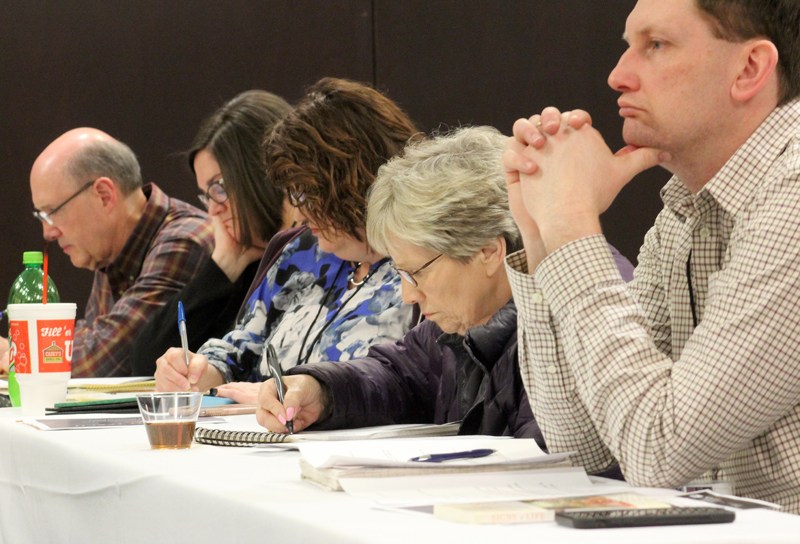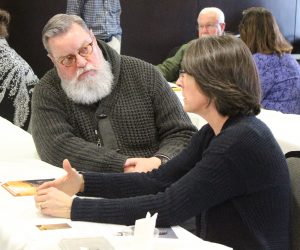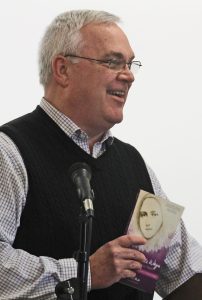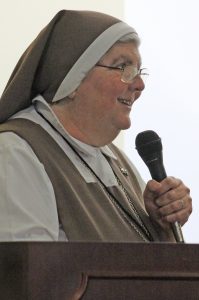Technology offers new ways of meeting, sharing religious education resources

Directors of religious education and catechists from around the Diocese of Peoria take notes during the "Called to Teach" religious education summit. The gathering gave them a chance to network, as well as hear about the plans the Office of Evangelization and Faith Formation has to support them. (The Catholic Post/Jennifer Willems)
Using technology to stay connected, share resources and even “meet” virtually is part of a new approach to religious education that was unveiled by the diocesan Office of Evangelization and Faith Formation during “Called to Teach.”
The “religious education summit” was held recently at the Spalding Pastoral Center in Peoria and included a talk by Alan Anderson. A former regional director of religious education, he now teaches theology at Chesterton Academy of the Sacred Heart in Peoria.
“Catechesis is very important and you’re doing that work for the Lord,” Sister Ana Pia Cordua, SCTJM, director of the Office of Evangelization and Faith Formation, told the directors of religious education and catechists. “You’re doing that for those Catholics that are growing to love God, so they can commit their lives to the Lord.”
Scripture says that faith is transmitted by hearing it, because it is by hearing it that we are called to be moved in our hearts, she said.
Getting to know God enables people of all ages to love him more, and the more they love, the more they will want to serve him and others, according to Sister Ana Pia.
“AVENUE OF COMMUNICATION”
In order for the office, which includes Julie Enzenberger, to be of greater service, Sister Ana Pia plans to visit every parish or cluster of parishes with a religious education program. Ideally, this would happen when classes are in session, she said.
“If I don’t know your needs, Julie and I cannot provide for them,” Sister Ana Pia explained, adding, “We need to get our feet wet in the same fields in which you are working.”
She asked that every parish establish a Gmail account for its religious education program to create an “avenue of communication” between the diocese and the parish and among the directors of religious education. Sister Ana Pia said the office could help them with this.

Brian Corrigan of Holy Cross in Mendota confers with Julia Mead of St. Louis in Princeton during the religious education summit. (The Catholic Post/Jennifer Willems)
“I would like it to be Gmail because there are many Google programs we can use,” she said, referring to virtual meetings.
Her religious community, the Servants of the Pierced Hearts of Jesus and Mary, uses Google Hangouts, for example, when it has classes or meetings.
“It keeps that human touch — not just using technology for technology’s sake,” Sister Ana Pia said.
Another goal is to have a common calendar, especially in each vicariate, that people can consult. This might enable them to share retreat days and resources for First Communion and other sacramental celebrations, she told them.
“We walk around with a great burden because we have to do things alone,” Sister Ana Pia said. “But if we work together, we can have resources in common.”
Among them is the Family Resources Center, “a treasure” in Peoria that offers courses, books, DVDs and videos for loan and will ship them to the parishes for their use, she said.
Another is continuing education and certification through Christendom College. Sister Ana Pia noted that grants are available through the Fulton Sheen Endowment and encouraged the DREs and catechists to apply.
She referred them to the page for the Office of Evangelization and Faith Formation on the website for the Catholic Diocese of Peoria for information on curriculum, sacraments and forms.
“GOLDEN AGE OF CATECHESIS”
All of the resources and programs available now make this a “golden age of catechesis,” according to Anderson.

“Try to look at every student and see a saint. God is preparing them for work that needs to be done,” Alan Anderson told the catechists. (The Catholic Post/Jennifer Willems)
“Look at the tools we have,” he said.
For inspiration, Anderson shared some insights from Susan Muto’s book, “Twelve Little Ways to Transform Your Heart: Lessons in Evangelization and Holiness from St. Thérèse of Lisieux.”
He started with the concept of simplicity, saying we are almost pre-programmed to seek complexity. “We want perfection,” Anderson said.
“Our intention is good, but we get so caught up in our own plans and ideas that we lose track of them,” he said, adding this can be detrimental if it leads to a “my way or the highway” attitude.
Simplicity leads to gratitude, Anderson said, and the greatest source of gratitude is the Eucharist, which means “thanksgiving.”
“God has given us all kinds of blessings,” he said. “Start to develop gratitude. Simplify your life and look at what God has placed in your life.”
Finally, he asked them to consider the “hiddenness” of St. Thérèse’s life. She has touched countless people, despite her cloistered life, he said.
“Try to look at every student and see a saint,” Anderson said. “God is preparing them for work that needs to be done.”






